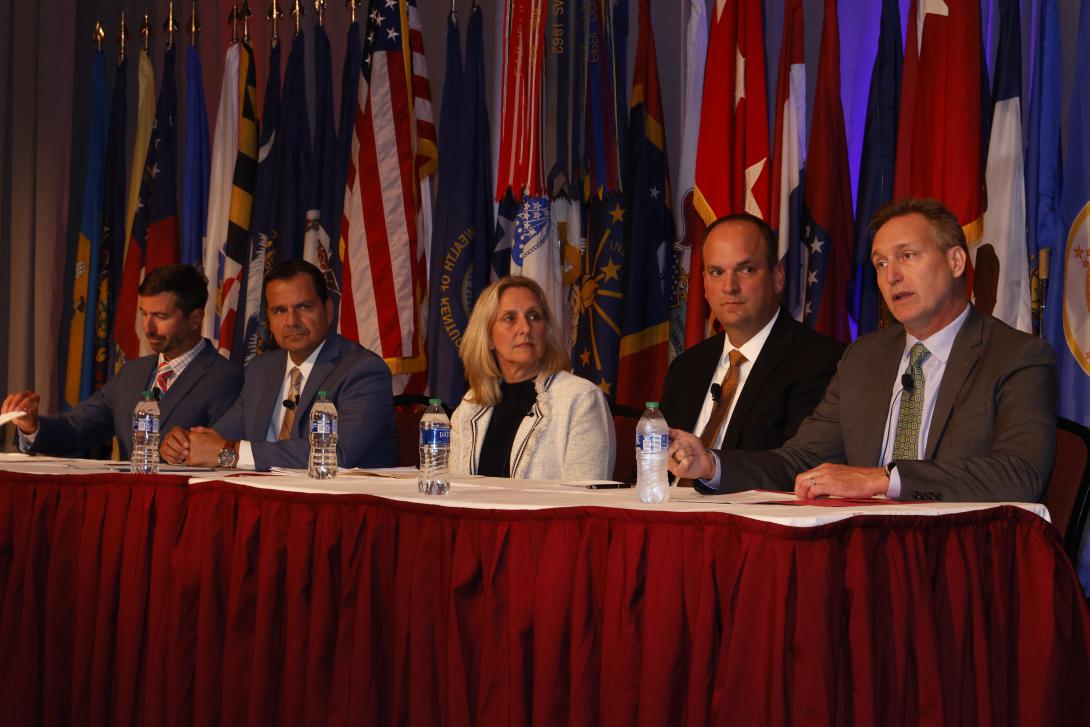Army PEOs Weave Data-Centric Future
U.S. Army program executive officers (PEOs) stressed the importance of open systems, data fabrics and tailorable common operating pictures during a joint panel presentation at the AFCEA TechNet Augusta 2022 conference in Augusta, Georgia.
Karen Saunders, PEO-Simulation, Training and Instrumentation, noted that modular open systems architectures (MOSAs) are important to all four of her major modernization areas, which include synthetic training environments, cyber training capabilities, intelligence training capabilities, and developing threat and signature capabilities for testing and training. “As we move forward, and as we’re looking at this unified environment, my PEO is moving toward an enterprise level MOSA tying in my live, constructive, virtual domains with all four programs, the modernizations efforts that I spoke to,” she said.
With the Synthetic Training Environment family of systems, her team already has developed an established MOSA that’s “going to be the core as I develop, as I mature, this enterprise MOSA” and “as we build the data fabric,” she noted. “And then the other programs will be meshed in as well.”
Data management and data fabric capabilities are key, she indicated. “My organization is looking to build a data fabric, and we’re using lessons learned from our fellow PEOs who have already established their data fabrics,” she reported. “Our intent is to stitch in or mesh in our data fabric with my fellow PEOs. I also am very concerned about the data that I need to operate my simulation models, whether it’s pre-sim data, run-time data or enterprise management data of our simulations.”
She also noted the importance of open application programming interfaces, common data standards and authoritative data. “We all deal with data. It’s the bread and butter of what we do, and our systems could not operate without data. If I’m going to train soldiers and have them conduct mission rehearsal on a training system, the data must be authoritative.”
Mark Kitz, PEO-Intelligence, Electronic Warfare and Sensors, agreed on the importance of open systems, saying he wants to “absolute amplify” Saunders’ open systems priority. “I am very encouraged by what I was hearing on the floor today, but you’re also starting to hear from the government a very integrated approach to how we’re delivering open systems. An integrated, multifunction way to deliver capability is something we are committed to,” he asserted.
Kitz also touted the importance of threat agnostic sensors. “We are focusing our sensor investment—and this is our challenge—we’re focusing our sensor investments on becoming more threat agnostic. I have to build sensors that can enter an environment without a predetermined understanding of what that environment’s going to be, on how the threat’s going to modify their capabilities to counter what I’m trying to sense or how I’m trying to understand the battlespace.”
With that comes a lot of opportunities, opportunities we haven’t necessarily had before, he added. “You name the program in my portfolio, you’re going to see a huge focus on open systems and getting after that priority of threat agnostic and being able to deliver a flexible data architecture that includes software and hardware.”
PEO Wish List from Industry
Ross Guckert, PEO-Enterprise Information Systems, touted the benefits of the Army Data and Analytics Platform program management office, which developed a tool for tailoring data visualization. The tool has thousands of users and has been used to assess risk and readiness, to support the Afghan withdrawal effort last year, to develop COVID maps and report vaccination status, and to identify unliquidated obligations, saving the Army billions of dollars. “It’s a tool that allows users to go in, take the data from authoritative sources and make their own visualizations that support their decision making.”
Guckert also reported that his office will soon release a solicitation to modernize the Secret Internet Protocol Router Network and also intends to modernize voice capabilities at every post, camp and station.
Nicholaus Saacks, PEO-Command, Control, Communications-Tactical, emphasized the need for a tactical data fabric, resilient networks, automated PACE planning—meaning an automated system to plan primary, alternate, contingency and emergency communications—and data security. “We need to be able to secure our data based on identity management both for people and nonperson entities so that the data is available to whoever needs to see it and only those who need to see it,” he said. “The better job we can do securing our data, the more transport options open up to us.”
Saacks also suggested a common operating picture, or COP, is not the goal. “We don’t want to field a singular COP to the Army. We want to field a tailorable operating picture to the Army because every commander is going to have a different need, to be able to see that data in a different way based on what his or her mission is, what their [area of responsibility] is, etc. We want to deliver a tailorable operating picture based on common data."





Comments